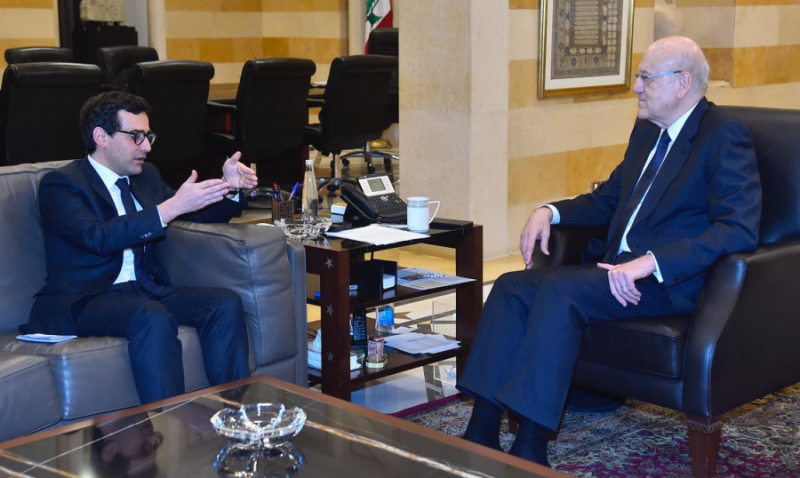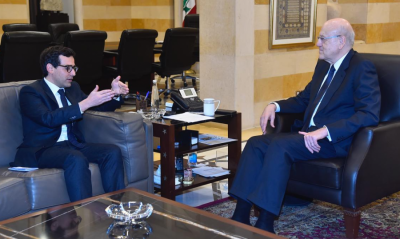Lebanon is waiting to receive the French proposals document that French Foreign Minister Stéphane Séjourné discussed with Lebanese officials on Sunday, as part of Paris's efforts to halt the escalation between Hezbollah and Israel. The proposal outlines a solution in three stages, starting with a halt to military operations, the return of displaced Lebanese and Israelis, and the initiation of a negotiation process that replicates the April 1996 Understanding, aiming to fully and finally stabilize the border regions. Séjourné concluded his visit to Beirut on Sunday, where he met with Lebanese officials and presented them with the details of the initiative he will also bring to Tel Aviv on Tuesday. At the end of his visit, he stated: "We reject the worst-case scenario in Lebanon. No one has an interest in continuing the escalation between Israel and Hezbollah." He affirmed that it is their responsibility to avoid escalation, noting their role in UNIFIL, where 700 soldiers are stationed.
The document has minor amendments compared to the previous version, which Lebanon received earlier through a joint delegation from the French Ministries of Foreign Affairs and Defense, and Paris has already received feedback on it. The modified document was presented by Séjourné to Lebanese officials on Sunday, where discussions took place. It is expected to be officially delivered to the Lebanese authorities later through the embassy in Beirut or by a delegation coming from Paris, following the existing customs.
### Gradual Implementation in Three Stages
A diplomatic source told "Asharq Al-Awsat" that the proposals were discussed, and Séjourné engaged with all responsible parties in Lebanon, including Parliament Speaker Nabih Berri, caretaker Prime Minister Najib Mikati, Foreign Minister Abdullah Bouhabib, and Army Commander Joseph Aoun, whom he met on Sunday. The document includes a solution in three phases.
The source clarified that the first phase, in the short term, entails ceasing military operations by Lebanese armed groups in exchange for stopping Israeli violations. This phase also includes a repositioning of Hezbollah in its deployment areas in the south. The term "repositioning" does not specify the distance of Hezbollah's withdrawal from the border area, and this point will be subject to a detailed negotiation process. Notably, this phrasing is considered a development over previous international initiatives that explicitly discussed Hezbollah withdrawing to distances ranging from 7 to 10 kilometers from the border with Israel.
The diplomatic source indicated that the second phase, to be implemented in the medium term, involves the return of displaced Lebanese to their villages alongside the return of displaced Israelis from northern Israel. This return is expected to be complete, referring to approximately 100,000 displaced Lebanese from the southern Lebanese border region and around 100,000 displaced Israelis from the northern border area.
The source pointed out that the third phase, set to be carried out in the long term, involves a replication of the April Understanding of 1996. It includes forming a quadruple or quintuple committee comprising representatives from the Lebanese and Israeli armies, UNIFIL, and the French and American armies to resolve the existing border dispute at 13 border points, as well as address disagreements over the town of Ghajar, the Shebaa Farms, and the Kfarshouba hills, which Israel occupied in 1967, territories that Lebanon asserts are Lebanese and not Syrian.
The planned quintuple committee will discuss the technical details related to fixing the borders as drawn in 1926 and established in the 1949 armistice agreement with Israel, and will hold discussions regarding boundary disputes along the blue line. Sources stated that this will be an opportunity to establish sustained stability along the southern borders.
Should a comprehensive solution be found for the border dispute involving the 13 points including the B1 point, the Shebaa Farms, Kfarshouba, and Ghajar, stability would exceed what the border region experienced from 2006 to 2023 when Resolution 1701 was not fully implemented. The border points remained unresolved, and Israeli air violations continued, though the region did not witness confrontations or military escalation.
### Resolution 1701 Sufficient for Sustainable Stability
Diplomatic sources confirmed that the framework of the French document relies on Resolution 1701, which will be sufficient for sustainable stability, and there was no need for a new framework or a mechanism different from 1701. They emphasized that France's role is vital in stabilizing the region with 700 soldiers participating in the UNIFIL mission, and France plays a significant role in establishing security and stability in the border area by increasing and stabilizing UNIFIL's daily patrols and clarifying UNIFIL's tasks and powers in cooperation with the Lebanese army. These matters were discussed during the recent visit of Lebanese Army Commander General Joseph Aoun to Paris.
Consequently, sources affirm that there is a practical, military, security, and diplomatic effort being made in parallel, to stabilize and end escalation, preparing the ground for sustainable stability to be ready for implementation upon the announcement of a ceasefire in Gaza. Hezbollah's commitment to cease fighting in southern Lebanon will align with the end of the war in Gaza, reflecting its declared stance, which the Lebanese state has echoed in official responses, stating that its involvement in supporting combat in the south will coincide with the conclusion of the war in Gaza.
Washington is also actively working to contain the escalation along the Lebanese-Israeli border, with its envoy Amos Hochstein visiting Jerusalem on Sunday, according to "Asharq Al-Awsat."




